Human Resource Management: Asda's Value and Organizational Success
VerifiedAdded on 2023/06/05
|10
|2763
|282
Report
AI Summary
This report delves into the crucial role of Human Resource Management (HRM) in driving organizational success, using Asda as a case study. It explores the importance of organizational design theories, including the Kaleidoscope change model and McKinsey's seven-framework, in shaping organizational structure and performance. The report also examines various approaches and techniques for creating a skilled and committed workforce, focusing on motivational theories like Maslow's hierarchy of needs and Herzberg's hygiene theory, alongside the significance of knowledge management. Furthermore, it provides recommendations for improving sustainable performance and analyzes emerging HR developments, such as globalization and workforce management, and their impact on the future role of HR, highlighting the importance of adapting to technological advancements and employee well-being. The report concludes with the role of HRM in ensuring success and growth of the organization.

Human Resource- Value and
Contribution to
Organizational Success
Contribution to
Organizational Success
Paraphrase This Document
Need a fresh take? Get an instant paraphrase of this document with our AI Paraphraser
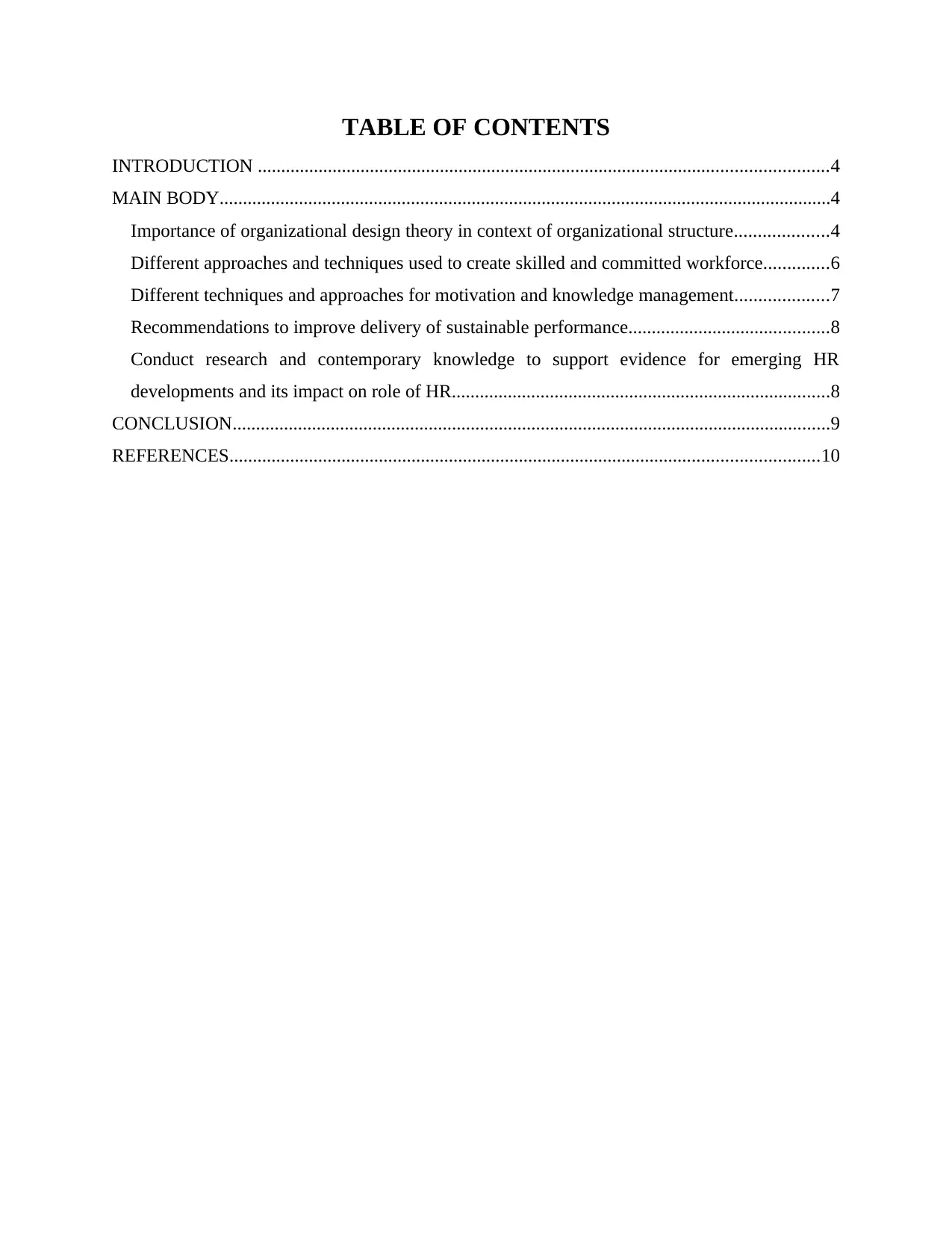
TABLE OF CONTENTS
INTRODUCTION ..........................................................................................................................4
MAIN BODY...................................................................................................................................4
Importance of organizational design theory in context of organizational structure....................4
Different approaches and techniques used to create skilled and committed workforce..............6
Different techniques and approaches for motivation and knowledge management....................7
Recommendations to improve delivery of sustainable performance...........................................8
Conduct research and contemporary knowledge to support evidence for emerging HR
developments and its impact on role of HR.................................................................................8
CONCLUSION................................................................................................................................9
REFERENCES..............................................................................................................................10
INTRODUCTION ..........................................................................................................................4
MAIN BODY...................................................................................................................................4
Importance of organizational design theory in context of organizational structure....................4
Different approaches and techniques used to create skilled and committed workforce..............6
Different techniques and approaches for motivation and knowledge management....................7
Recommendations to improve delivery of sustainable performance...........................................8
Conduct research and contemporary knowledge to support evidence for emerging HR
developments and its impact on role of HR.................................................................................8
CONCLUSION................................................................................................................................9
REFERENCES..............................................................................................................................10

⊘ This is a preview!⊘
Do you want full access?
Subscribe today to unlock all pages.

Trusted by 1+ million students worldwide

INTRODUCTION
Human resource management is very essential for the success of an organization. They
are the one who are responsible for hiring skilled and talented employees, motivating them and
encouraging them to put all their efforts towards success and growth of business. The
organization that is selected for the project is Asda which is a British supermarket chain
headquartered in Leeds, England. The company offers groceries, clothing, home appliances and
electronics, toys and health and beauty products. It also renders services such as insurance and
financial services. The project will highlight the importance of organizational design in
delivering sustainable performance of organization. It will also include requirement of
motivated, knowledgable and experienced individual and team within organization. Lastly there
will be a contemporary research on impact of emerging HR developments on role of HR in the
future.
MAIN BODY
Importance of organizational design theory in context of organizational structure
Kaleidoscope change model
The change management is discusses the transformation in business, technology and aim.
Kaleidoscope change model is the most effective change model which is adapted by Asda to
adapt and cope up with changes taking place in environment. To implement changes in business
certain power and amount of care ability is required. The change can be effectively implemented
with the help of efficient leaders (Haggblade and et.al., 2019). The company is required to set
flexible goals and objective that can be modified according to changes in business environment
which can enable it to expand its business in global market and achieve success.
McKinsey's seven framework
McKinsey's framework is divided into two elements: hard element and soft element. Hard
element includes system, structure and strategies on the other hand soft elements include skill,
shared value, staff and style. The main benefit of this model is that it examines the effect of
certain changes on business and its operations. Asda has applied McKinsey's seven framework in
business to gain advantage and ensure success.
Strategy: The strategy and direction of Asda is clearly defined and communicated with
employees and stakeholders of company (Demir and Kocaoglu, 2019). This enables company to
Human resource management is very essential for the success of an organization. They
are the one who are responsible for hiring skilled and talented employees, motivating them and
encouraging them to put all their efforts towards success and growth of business. The
organization that is selected for the project is Asda which is a British supermarket chain
headquartered in Leeds, England. The company offers groceries, clothing, home appliances and
electronics, toys and health and beauty products. It also renders services such as insurance and
financial services. The project will highlight the importance of organizational design in
delivering sustainable performance of organization. It will also include requirement of
motivated, knowledgable and experienced individual and team within organization. Lastly there
will be a contemporary research on impact of emerging HR developments on role of HR in the
future.
MAIN BODY
Importance of organizational design theory in context of organizational structure
Kaleidoscope change model
The change management is discusses the transformation in business, technology and aim.
Kaleidoscope change model is the most effective change model which is adapted by Asda to
adapt and cope up with changes taking place in environment. To implement changes in business
certain power and amount of care ability is required. The change can be effectively implemented
with the help of efficient leaders (Haggblade and et.al., 2019). The company is required to set
flexible goals and objective that can be modified according to changes in business environment
which can enable it to expand its business in global market and achieve success.
McKinsey's seven framework
McKinsey's framework is divided into two elements: hard element and soft element. Hard
element includes system, structure and strategies on the other hand soft elements include skill,
shared value, staff and style. The main benefit of this model is that it examines the effect of
certain changes on business and its operations. Asda has applied McKinsey's seven framework in
business to gain advantage and ensure success.
Strategy: The strategy and direction of Asda is clearly defined and communicated with
employees and stakeholders of company (Demir and Kocaoglu, 2019). This enables company to
Paraphrase This Document
Need a fresh take? Get an instant paraphrase of this document with our AI Paraphraser
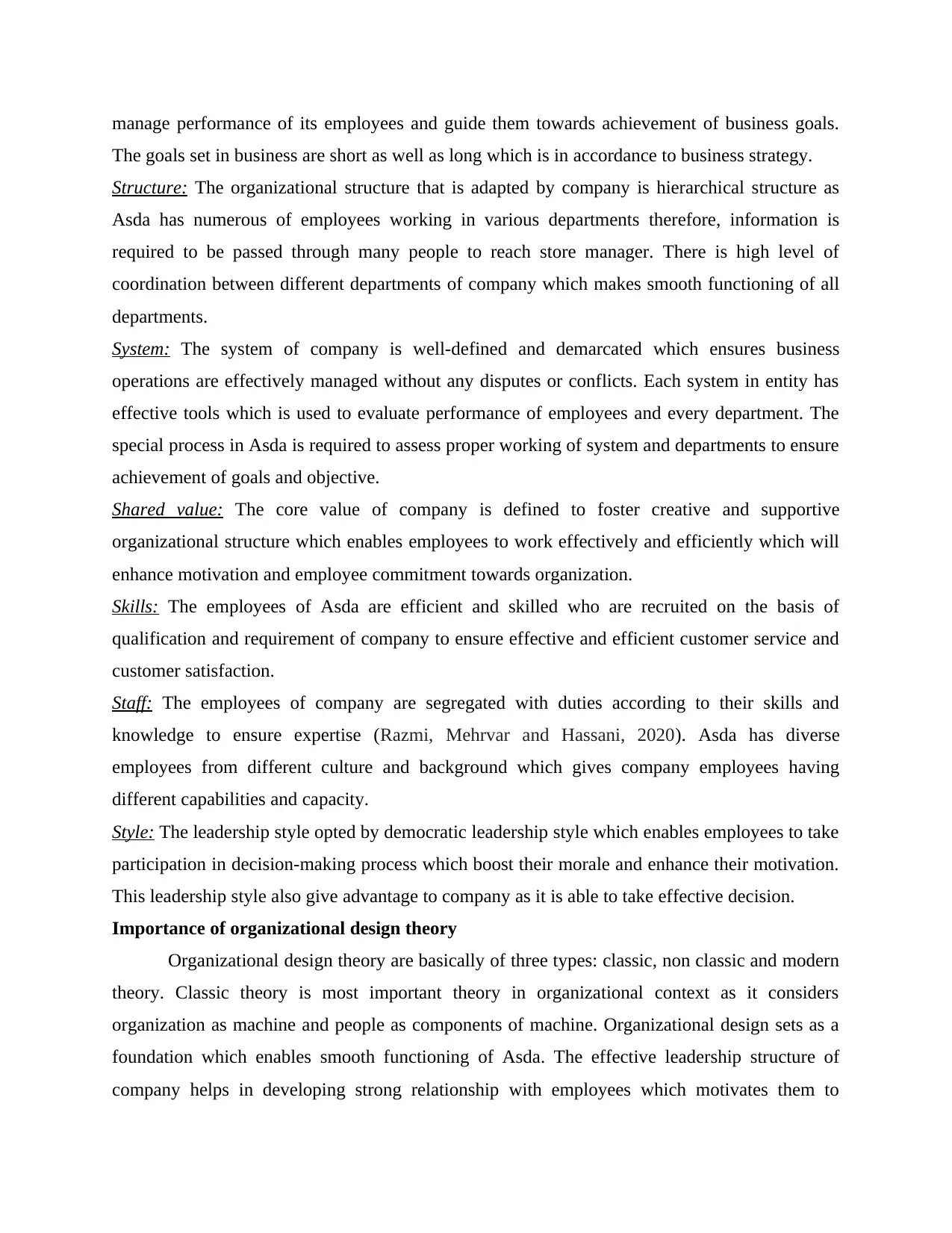
manage performance of its employees and guide them towards achievement of business goals.
The goals set in business are short as well as long which is in accordance to business strategy.
Structure: The organizational structure that is adapted by company is hierarchical structure as
Asda has numerous of employees working in various departments therefore, information is
required to be passed through many people to reach store manager. There is high level of
coordination between different departments of company which makes smooth functioning of all
departments.
System: The system of company is well-defined and demarcated which ensures business
operations are effectively managed without any disputes or conflicts. Each system in entity has
effective tools which is used to evaluate performance of employees and every department. The
special process in Asda is required to assess proper working of system and departments to ensure
achievement of goals and objective.
Shared value: The core value of company is defined to foster creative and supportive
organizational structure which enables employees to work effectively and efficiently which will
enhance motivation and employee commitment towards organization.
Skills: The employees of Asda are efficient and skilled who are recruited on the basis of
qualification and requirement of company to ensure effective and efficient customer service and
customer satisfaction.
Staff: The employees of company are segregated with duties according to their skills and
knowledge to ensure expertise (Razmi, Mehrvar and Hassani, 2020). Asda has diverse
employees from different culture and background which gives company employees having
different capabilities and capacity.
Style: The leadership style opted by democratic leadership style which enables employees to take
participation in decision-making process which boost their morale and enhance their motivation.
This leadership style also give advantage to company as it is able to take effective decision.
Importance of organizational design theory
Organizational design theory are basically of three types: classic, non classic and modern
theory. Classic theory is most important theory in organizational context as it considers
organization as machine and people as components of machine. Organizational design sets as a
foundation which enables smooth functioning of Asda. The effective leadership structure of
company helps in developing strong relationship with employees which motivates them to
The goals set in business are short as well as long which is in accordance to business strategy.
Structure: The organizational structure that is adapted by company is hierarchical structure as
Asda has numerous of employees working in various departments therefore, information is
required to be passed through many people to reach store manager. There is high level of
coordination between different departments of company which makes smooth functioning of all
departments.
System: The system of company is well-defined and demarcated which ensures business
operations are effectively managed without any disputes or conflicts. Each system in entity has
effective tools which is used to evaluate performance of employees and every department. The
special process in Asda is required to assess proper working of system and departments to ensure
achievement of goals and objective.
Shared value: The core value of company is defined to foster creative and supportive
organizational structure which enables employees to work effectively and efficiently which will
enhance motivation and employee commitment towards organization.
Skills: The employees of Asda are efficient and skilled who are recruited on the basis of
qualification and requirement of company to ensure effective and efficient customer service and
customer satisfaction.
Staff: The employees of company are segregated with duties according to their skills and
knowledge to ensure expertise (Razmi, Mehrvar and Hassani, 2020). Asda has diverse
employees from different culture and background which gives company employees having
different capabilities and capacity.
Style: The leadership style opted by democratic leadership style which enables employees to take
participation in decision-making process which boost their morale and enhance their motivation.
This leadership style also give advantage to company as it is able to take effective decision.
Importance of organizational design theory
Organizational design theory are basically of three types: classic, non classic and modern
theory. Classic theory is most important theory in organizational context as it considers
organization as machine and people as components of machine. Organizational design sets as a
foundation which enables smooth functioning of Asda. The effective leadership structure of
company helps in developing strong relationship with employees which motivates them to

enhance their productivity and performance (Fjeldstad and Snow, 2018). It also helps in building
team and effective coordination of employees in accomplishment of common goals.
Organizational structure and design enables Asda in future growth and development and
expansion of business. The kaleidoscope change model adapted by company has enabled it to
understand importance of organizational structure and adapt the changes in environment which
can ensure business success. The selection of organizational design is according to goal, aim,
structure and style. It is essential for company to identify and adapt the changes in environment
and make its employees to adapt changes that are taking place within entity (Bocken and
Geradts, 2020). This can be ensured by effective leadership and this result into overall
development and growth of business. McKinsey's framework helps Asda to adapt changes in
accordance to strong structure and strategies and other elements.
Different approaches and techniques used to create skilled and committed workforce
Motivational theories
Motivation is essential in business to enable organization to boost morale and enhance
performance and commitment of employees which will ensure overall growth and development
of organization and gain competitive advantage. There are different types of motivational
theories that can be adapted by organization.
Maslow need theory
According to Maslow, every individual has needs which are arranged in physiology
order. The needs of employees in an organization differ from each other and it is responsibility
of HRM to identify the needs of employees and give rewards and incentives accordingly. The
needs of individual are build in a pyramid form and when individual accomplish first stage of
need they are motivated for achieving further stages. From this motivational theory it can be
analysed that foremost need of employees in organization is salary which can provide them
comfortable life. The second need is health and safety and when employees reach this stage they
work hard to achieve their further requirements (Trivedi and Mehta, 2019). Asda uses this
motivational theory to motivate their employees by providing adequate incentives and rewards to
employees according to their performance. The HRM of company offers attractive salary to its
employees to meet their physiological need. It is responsibility of HRM to develop healthy and
safe work culture and provide adequate incentives to meet staff esteem needs. This motivates
employees to put all their efforts for accomplishment of organizational goals and objective.
team and effective coordination of employees in accomplishment of common goals.
Organizational structure and design enables Asda in future growth and development and
expansion of business. The kaleidoscope change model adapted by company has enabled it to
understand importance of organizational structure and adapt the changes in environment which
can ensure business success. The selection of organizational design is according to goal, aim,
structure and style. It is essential for company to identify and adapt the changes in environment
and make its employees to adapt changes that are taking place within entity (Bocken and
Geradts, 2020). This can be ensured by effective leadership and this result into overall
development and growth of business. McKinsey's framework helps Asda to adapt changes in
accordance to strong structure and strategies and other elements.
Different approaches and techniques used to create skilled and committed workforce
Motivational theories
Motivation is essential in business to enable organization to boost morale and enhance
performance and commitment of employees which will ensure overall growth and development
of organization and gain competitive advantage. There are different types of motivational
theories that can be adapted by organization.
Maslow need theory
According to Maslow, every individual has needs which are arranged in physiology
order. The needs of employees in an organization differ from each other and it is responsibility
of HRM to identify the needs of employees and give rewards and incentives accordingly. The
needs of individual are build in a pyramid form and when individual accomplish first stage of
need they are motivated for achieving further stages. From this motivational theory it can be
analysed that foremost need of employees in organization is salary which can provide them
comfortable life. The second need is health and safety and when employees reach this stage they
work hard to achieve their further requirements (Trivedi and Mehta, 2019). Asda uses this
motivational theory to motivate their employees by providing adequate incentives and rewards to
employees according to their performance. The HRM of company offers attractive salary to its
employees to meet their physiological need. It is responsibility of HRM to develop healthy and
safe work culture and provide adequate incentives to meet staff esteem needs. This motivates
employees to put all their efforts for accomplishment of organizational goals and objective.
⊘ This is a preview!⊘
Do you want full access?
Subscribe today to unlock all pages.

Trusted by 1+ million students worldwide
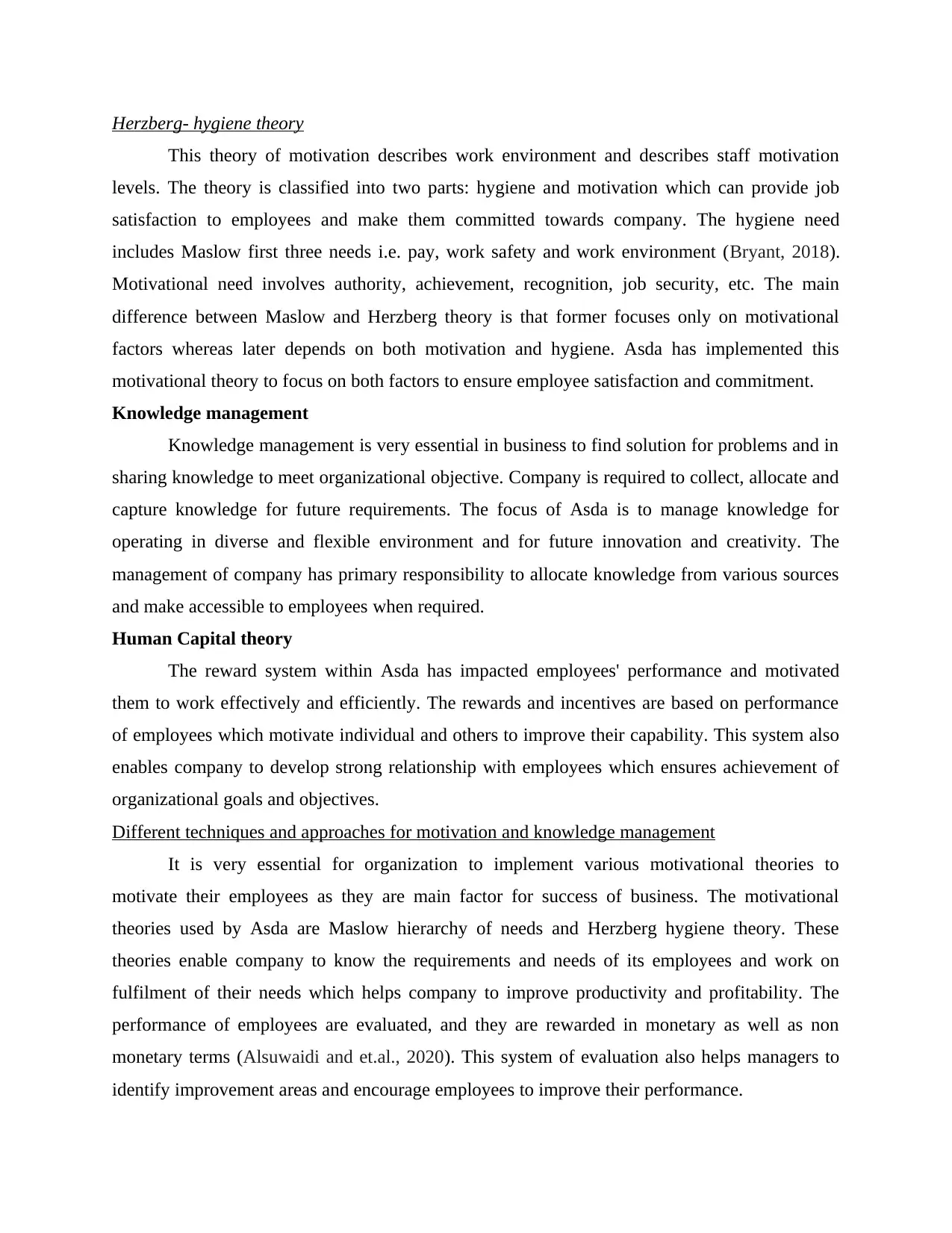
Herzberg- hygiene theory
This theory of motivation describes work environment and describes staff motivation
levels. The theory is classified into two parts: hygiene and motivation which can provide job
satisfaction to employees and make them committed towards company. The hygiene need
includes Maslow first three needs i.e. pay, work safety and work environment (Bryant, 2018).
Motivational need involves authority, achievement, recognition, job security, etc. The main
difference between Maslow and Herzberg theory is that former focuses only on motivational
factors whereas later depends on both motivation and hygiene. Asda has implemented this
motivational theory to focus on both factors to ensure employee satisfaction and commitment.
Knowledge management
Knowledge management is very essential in business to find solution for problems and in
sharing knowledge to meet organizational objective. Company is required to collect, allocate and
capture knowledge for future requirements. The focus of Asda is to manage knowledge for
operating in diverse and flexible environment and for future innovation and creativity. The
management of company has primary responsibility to allocate knowledge from various sources
and make accessible to employees when required.
Human Capital theory
The reward system within Asda has impacted employees' performance and motivated
them to work effectively and efficiently. The rewards and incentives are based on performance
of employees which motivate individual and others to improve their capability. This system also
enables company to develop strong relationship with employees which ensures achievement of
organizational goals and objectives.
Different techniques and approaches for motivation and knowledge management
It is very essential for organization to implement various motivational theories to
motivate their employees as they are main factor for success of business. The motivational
theories used by Asda are Maslow hierarchy of needs and Herzberg hygiene theory. These
theories enable company to know the requirements and needs of its employees and work on
fulfilment of their needs which helps company to improve productivity and profitability. The
performance of employees are evaluated, and they are rewarded in monetary as well as non
monetary terms (Alsuwaidi and et.al., 2020). This system of evaluation also helps managers to
identify improvement areas and encourage employees to improve their performance.
This theory of motivation describes work environment and describes staff motivation
levels. The theory is classified into two parts: hygiene and motivation which can provide job
satisfaction to employees and make them committed towards company. The hygiene need
includes Maslow first three needs i.e. pay, work safety and work environment (Bryant, 2018).
Motivational need involves authority, achievement, recognition, job security, etc. The main
difference between Maslow and Herzberg theory is that former focuses only on motivational
factors whereas later depends on both motivation and hygiene. Asda has implemented this
motivational theory to focus on both factors to ensure employee satisfaction and commitment.
Knowledge management
Knowledge management is very essential in business to find solution for problems and in
sharing knowledge to meet organizational objective. Company is required to collect, allocate and
capture knowledge for future requirements. The focus of Asda is to manage knowledge for
operating in diverse and flexible environment and for future innovation and creativity. The
management of company has primary responsibility to allocate knowledge from various sources
and make accessible to employees when required.
Human Capital theory
The reward system within Asda has impacted employees' performance and motivated
them to work effectively and efficiently. The rewards and incentives are based on performance
of employees which motivate individual and others to improve their capability. This system also
enables company to develop strong relationship with employees which ensures achievement of
organizational goals and objectives.
Different techniques and approaches for motivation and knowledge management
It is very essential for organization to implement various motivational theories to
motivate their employees as they are main factor for success of business. The motivational
theories used by Asda are Maslow hierarchy of needs and Herzberg hygiene theory. These
theories enable company to know the requirements and needs of its employees and work on
fulfilment of their needs which helps company to improve productivity and profitability. The
performance of employees are evaluated, and they are rewarded in monetary as well as non
monetary terms (Alsuwaidi and et.al., 2020). This system of evaluation also helps managers to
identify improvement areas and encourage employees to improve their performance.
Paraphrase This Document
Need a fresh take? Get an instant paraphrase of this document with our AI Paraphraser
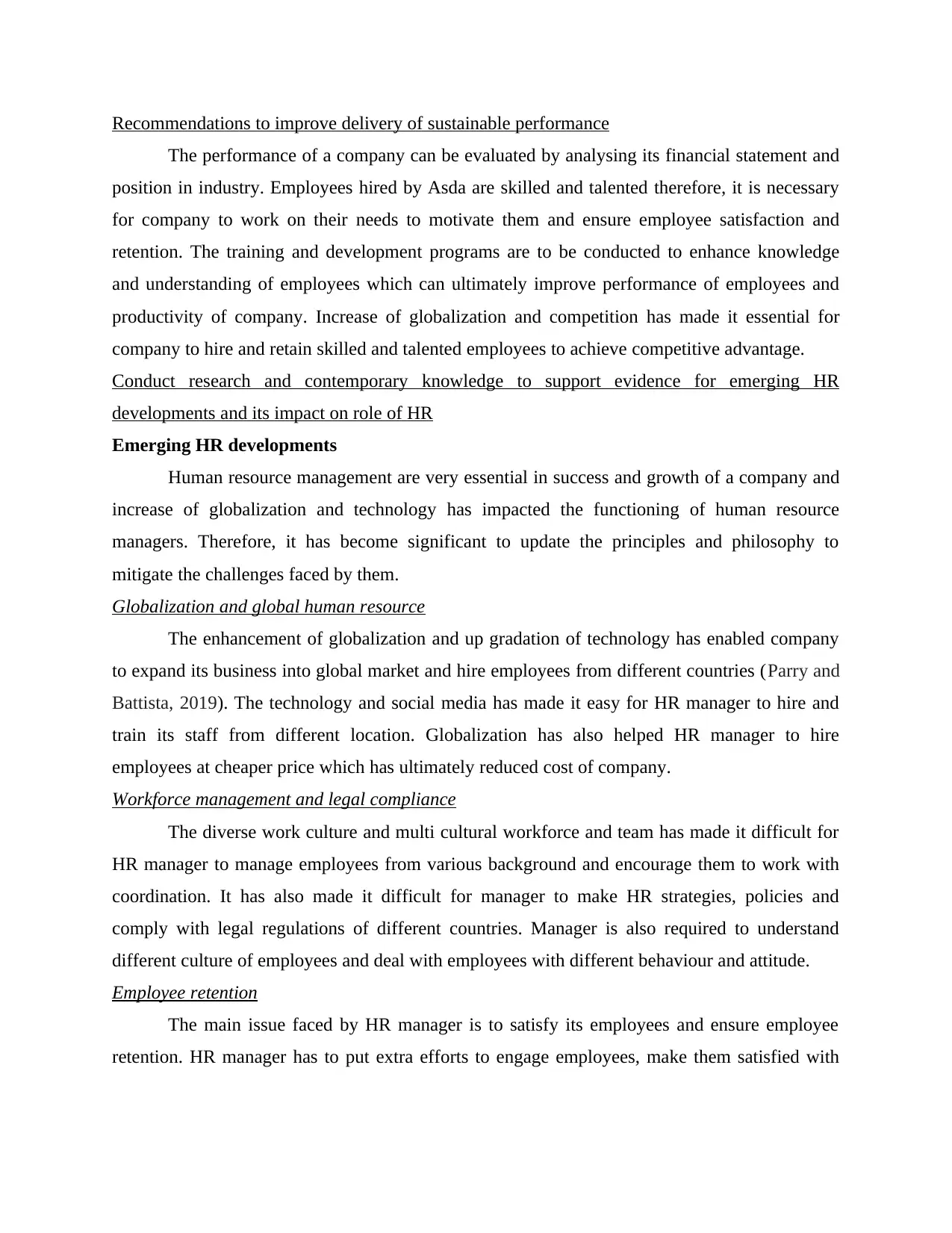
Recommendations to improve delivery of sustainable performance
The performance of a company can be evaluated by analysing its financial statement and
position in industry. Employees hired by Asda are skilled and talented therefore, it is necessary
for company to work on their needs to motivate them and ensure employee satisfaction and
retention. The training and development programs are to be conducted to enhance knowledge
and understanding of employees which can ultimately improve performance of employees and
productivity of company. Increase of globalization and competition has made it essential for
company to hire and retain skilled and talented employees to achieve competitive advantage.
Conduct research and contemporary knowledge to support evidence for emerging HR
developments and its impact on role of HR
Emerging HR developments
Human resource management are very essential in success and growth of a company and
increase of globalization and technology has impacted the functioning of human resource
managers. Therefore, it has become significant to update the principles and philosophy to
mitigate the challenges faced by them.
Globalization and global human resource
The enhancement of globalization and up gradation of technology has enabled company
to expand its business into global market and hire employees from different countries (Parry and
Battista, 2019). The technology and social media has made it easy for HR manager to hire and
train its staff from different location. Globalization has also helped HR manager to hire
employees at cheaper price which has ultimately reduced cost of company.
Workforce management and legal compliance
The diverse work culture and multi cultural workforce and team has made it difficult for
HR manager to manage employees from various background and encourage them to work with
coordination. It has also made it difficult for manager to make HR strategies, policies and
comply with legal regulations of different countries. Manager is also required to understand
different culture of employees and deal with employees with different behaviour and attitude.
Employee retention
The main issue faced by HR manager is to satisfy its employees and ensure employee
retention. HR manager has to put extra efforts to engage employees, make them satisfied with
The performance of a company can be evaluated by analysing its financial statement and
position in industry. Employees hired by Asda are skilled and talented therefore, it is necessary
for company to work on their needs to motivate them and ensure employee satisfaction and
retention. The training and development programs are to be conducted to enhance knowledge
and understanding of employees which can ultimately improve performance of employees and
productivity of company. Increase of globalization and competition has made it essential for
company to hire and retain skilled and talented employees to achieve competitive advantage.
Conduct research and contemporary knowledge to support evidence for emerging HR
developments and its impact on role of HR
Emerging HR developments
Human resource management are very essential in success and growth of a company and
increase of globalization and technology has impacted the functioning of human resource
managers. Therefore, it has become significant to update the principles and philosophy to
mitigate the challenges faced by them.
Globalization and global human resource
The enhancement of globalization and up gradation of technology has enabled company
to expand its business into global market and hire employees from different countries (Parry and
Battista, 2019). The technology and social media has made it easy for HR manager to hire and
train its staff from different location. Globalization has also helped HR manager to hire
employees at cheaper price which has ultimately reduced cost of company.
Workforce management and legal compliance
The diverse work culture and multi cultural workforce and team has made it difficult for
HR manager to manage employees from various background and encourage them to work with
coordination. It has also made it difficult for manager to make HR strategies, policies and
comply with legal regulations of different countries. Manager is also required to understand
different culture of employees and deal with employees with different behaviour and attitude.
Employee retention
The main issue faced by HR manager is to satisfy its employees and ensure employee
retention. HR manager has to put extra efforts to engage employees, make them satisfied with
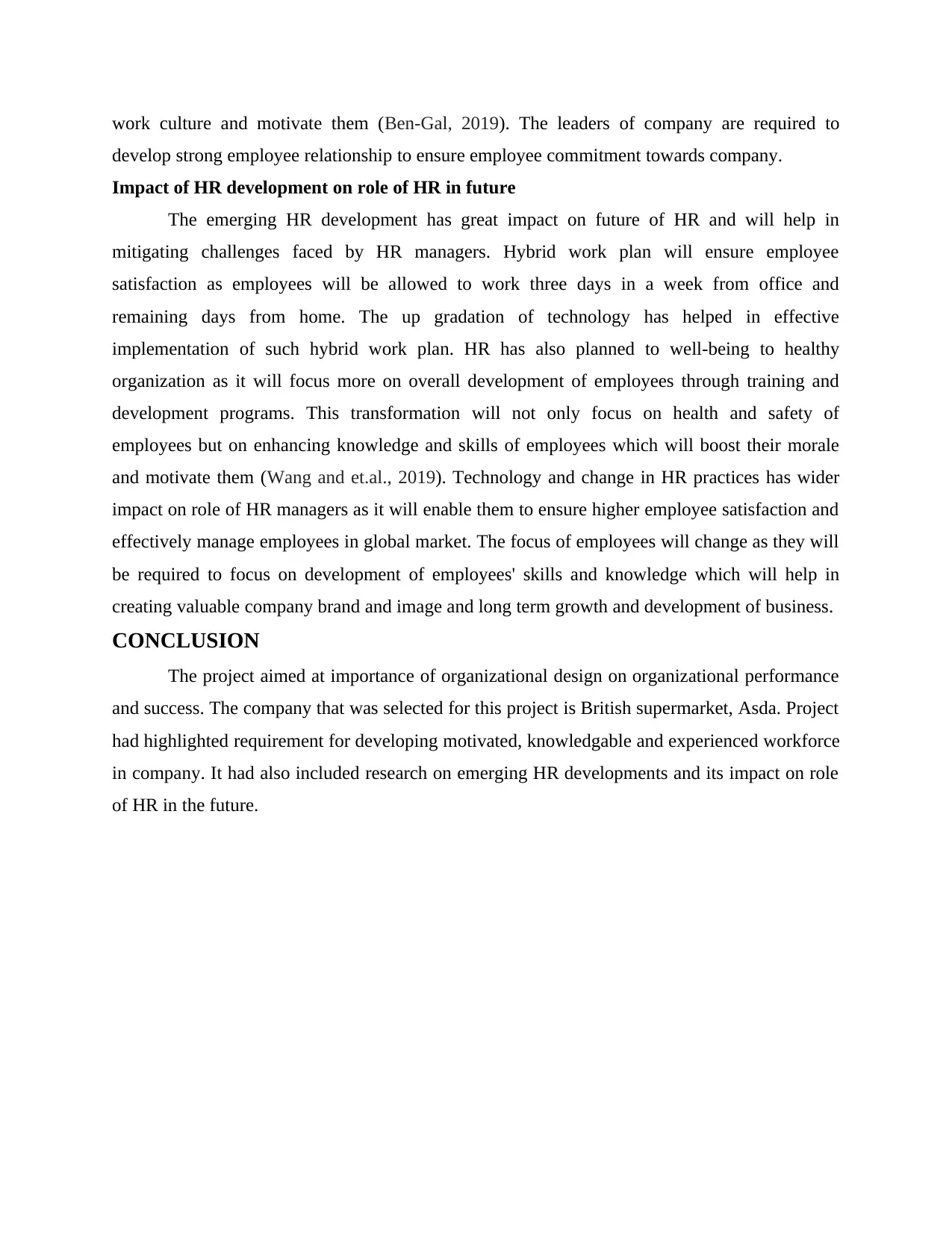
work culture and motivate them (Ben-Gal, 2019). The leaders of company are required to
develop strong employee relationship to ensure employee commitment towards company.
Impact of HR development on role of HR in future
The emerging HR development has great impact on future of HR and will help in
mitigating challenges faced by HR managers. Hybrid work plan will ensure employee
satisfaction as employees will be allowed to work three days in a week from office and
remaining days from home. The up gradation of technology has helped in effective
implementation of such hybrid work plan. HR has also planned to well-being to healthy
organization as it will focus more on overall development of employees through training and
development programs. This transformation will not only focus on health and safety of
employees but on enhancing knowledge and skills of employees which will boost their morale
and motivate them (Wang and et.al., 2019). Technology and change in HR practices has wider
impact on role of HR managers as it will enable them to ensure higher employee satisfaction and
effectively manage employees in global market. The focus of employees will change as they will
be required to focus on development of employees' skills and knowledge which will help in
creating valuable company brand and image and long term growth and development of business.
CONCLUSION
The project aimed at importance of organizational design on organizational performance
and success. The company that was selected for this project is British supermarket, Asda. Project
had highlighted requirement for developing motivated, knowledgable and experienced workforce
in company. It had also included research on emerging HR developments and its impact on role
of HR in the future.
develop strong employee relationship to ensure employee commitment towards company.
Impact of HR development on role of HR in future
The emerging HR development has great impact on future of HR and will help in
mitigating challenges faced by HR managers. Hybrid work plan will ensure employee
satisfaction as employees will be allowed to work three days in a week from office and
remaining days from home. The up gradation of technology has helped in effective
implementation of such hybrid work plan. HR has also planned to well-being to healthy
organization as it will focus more on overall development of employees through training and
development programs. This transformation will not only focus on health and safety of
employees but on enhancing knowledge and skills of employees which will boost their morale
and motivate them (Wang and et.al., 2019). Technology and change in HR practices has wider
impact on role of HR managers as it will enable them to ensure higher employee satisfaction and
effectively manage employees in global market. The focus of employees will change as they will
be required to focus on development of employees' skills and knowledge which will help in
creating valuable company brand and image and long term growth and development of business.
CONCLUSION
The project aimed at importance of organizational design on organizational performance
and success. The company that was selected for this project is British supermarket, Asda. Project
had highlighted requirement for developing motivated, knowledgable and experienced workforce
in company. It had also included research on emerging HR developments and its impact on role
of HR in the future.
⊘ This is a preview!⊘
Do you want full access?
Subscribe today to unlock all pages.

Trusted by 1+ million students worldwide
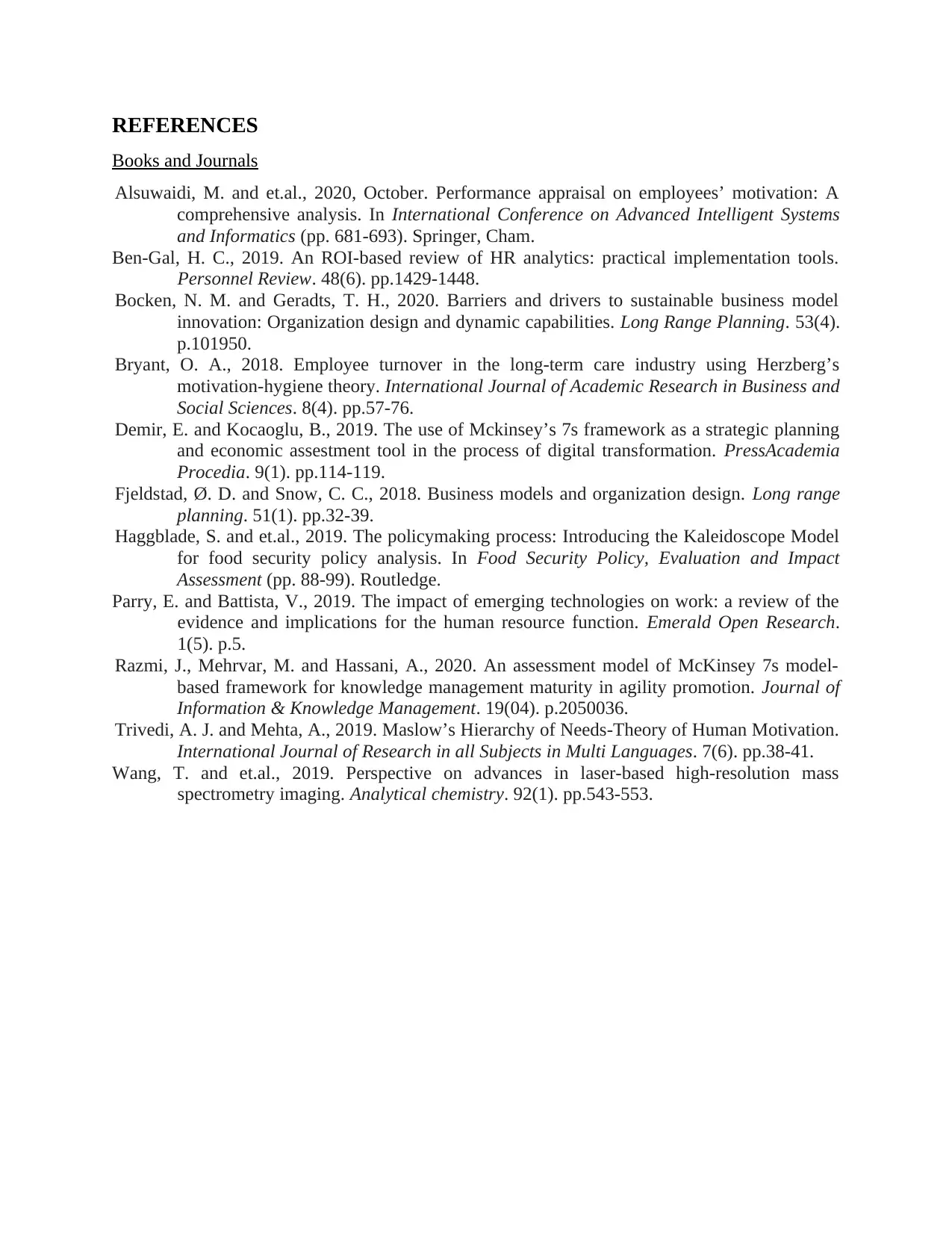
REFERENCES
Books and Journals
Alsuwaidi, M. and et.al., 2020, October. Performance appraisal on employees’ motivation: A
comprehensive analysis. In International Conference on Advanced Intelligent Systems
and Informatics (pp. 681-693). Springer, Cham.
Ben-Gal, H. C., 2019. An ROI-based review of HR analytics: practical implementation tools.
Personnel Review. 48(6). pp.1429-1448.
Bocken, N. M. and Geradts, T. H., 2020. Barriers and drivers to sustainable business model
innovation: Organization design and dynamic capabilities. Long Range Planning. 53(4).
p.101950.
Bryant, O. A., 2018. Employee turnover in the long-term care industry using Herzberg’s
motivation-hygiene theory. International Journal of Academic Research in Business and
Social Sciences. 8(4). pp.57-76.
Demir, E. and Kocaoglu, B., 2019. The use of Mckinsey’s 7s framework as a strategic planning
and economic assestment tool in the process of digital transformation. PressAcademia
Procedia. 9(1). pp.114-119.
Fjeldstad, Ø. D. and Snow, C. C., 2018. Business models and organization design. Long range
planning. 51(1). pp.32-39.
Haggblade, S. and et.al., 2019. The policymaking process: Introducing the Kaleidoscope Model
for food security policy analysis. In Food Security Policy, Evaluation and Impact
Assessment (pp. 88-99). Routledge.
Parry, E. and Battista, V., 2019. The impact of emerging technologies on work: a review of the
evidence and implications for the human resource function. Emerald Open Research.
1(5). p.5.
Razmi, J., Mehrvar, M. and Hassani, A., 2020. An assessment model of McKinsey 7s model-
based framework for knowledge management maturity in agility promotion. Journal of
Information & Knowledge Management. 19(04). p.2050036.
Trivedi, A. J. and Mehta, A., 2019. Maslow’s Hierarchy of Needs-Theory of Human Motivation.
International Journal of Research in all Subjects in Multi Languages. 7(6). pp.38-41.
Wang, T. and et.al., 2019. Perspective on advances in laser-based high-resolution mass
spectrometry imaging. Analytical chemistry. 92(1). pp.543-553.
Books and Journals
Alsuwaidi, M. and et.al., 2020, October. Performance appraisal on employees’ motivation: A
comprehensive analysis. In International Conference on Advanced Intelligent Systems
and Informatics (pp. 681-693). Springer, Cham.
Ben-Gal, H. C., 2019. An ROI-based review of HR analytics: practical implementation tools.
Personnel Review. 48(6). pp.1429-1448.
Bocken, N. M. and Geradts, T. H., 2020. Barriers and drivers to sustainable business model
innovation: Organization design and dynamic capabilities. Long Range Planning. 53(4).
p.101950.
Bryant, O. A., 2018. Employee turnover in the long-term care industry using Herzberg’s
motivation-hygiene theory. International Journal of Academic Research in Business and
Social Sciences. 8(4). pp.57-76.
Demir, E. and Kocaoglu, B., 2019. The use of Mckinsey’s 7s framework as a strategic planning
and economic assestment tool in the process of digital transformation. PressAcademia
Procedia. 9(1). pp.114-119.
Fjeldstad, Ø. D. and Snow, C. C., 2018. Business models and organization design. Long range
planning. 51(1). pp.32-39.
Haggblade, S. and et.al., 2019. The policymaking process: Introducing the Kaleidoscope Model
for food security policy analysis. In Food Security Policy, Evaluation and Impact
Assessment (pp. 88-99). Routledge.
Parry, E. and Battista, V., 2019. The impact of emerging technologies on work: a review of the
evidence and implications for the human resource function. Emerald Open Research.
1(5). p.5.
Razmi, J., Mehrvar, M. and Hassani, A., 2020. An assessment model of McKinsey 7s model-
based framework for knowledge management maturity in agility promotion. Journal of
Information & Knowledge Management. 19(04). p.2050036.
Trivedi, A. J. and Mehta, A., 2019. Maslow’s Hierarchy of Needs-Theory of Human Motivation.
International Journal of Research in all Subjects in Multi Languages. 7(6). pp.38-41.
Wang, T. and et.al., 2019. Perspective on advances in laser-based high-resolution mass
spectrometry imaging. Analytical chemistry. 92(1). pp.543-553.
1 out of 10
Related Documents
Your All-in-One AI-Powered Toolkit for Academic Success.
+13062052269
info@desklib.com
Available 24*7 on WhatsApp / Email
![[object Object]](/_next/static/media/star-bottom.7253800d.svg)
Unlock your academic potential
Copyright © 2020–2025 A2Z Services. All Rights Reserved. Developed and managed by ZUCOL.

